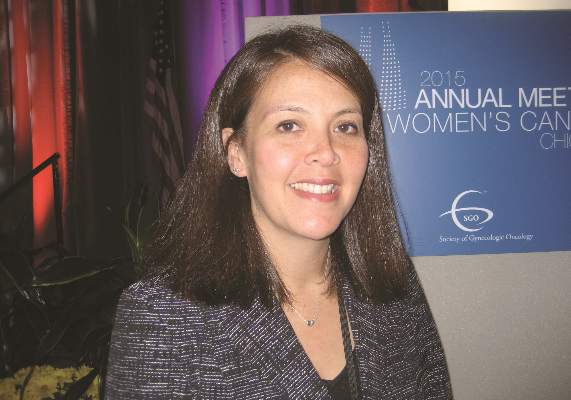User login
CHICAGO – Sentinel lymph node mapping alone may suffice for initial staging in women with clinical high-risk endometrial cancer, according to a prospective cohort study reported at the annual meeting of the Society of Gynecologic Oncology.
“While the majority of women with endometrial cancer do not have nodal involvement, positive nodes are an important prognostic factor and often guide postoperative adjuvant therapy. The use of SLN [sentinel lymph node] mapping could potentially maximize the identification of positive nodes while minimizing the risk of full lymphadenectomy,” noted Dr. Pamela T. Soliman, Center Medical Director of the Gynecologic Medical Center at The University of Texas MD Anderson Cancer Center, Houston.
 |
| Susan London/Frontline Medical News |
Dr. Pamela Soliman |
She and her colleagues studied 60 women who had clinical stage II disease with high-risk features on preoperative biopsy. All women underwent preoperative PET-CT, then SLN mapping, and finally a full surgical staging with pelvic and para-aortic lymphadenectomy to the renal vessels.
Results showed that 92% of women had at least one SLN detected and 61% had SLNs detected bilaterally. “These findings are consistent with others reported in the literature suggesting that this technique is reproducible,” Dr. Soliman maintained.
Importantly, she said, all of the patients ultimately found to have stage IIIc disease had at least one positive SLN identified, translating to a sensitivity of SLN mapping of 100% and a false-negative rate of zero.
“While we do not expect that the true false-negative rate is zero in this patient population, our results are very promising, and we are hopeful that with our study and other studies presented here, we can potentially change the way we manage patients with high-risk endometrial cancer,” she said.
“If we continue to successfully identify the women with positive lymph nodes using the mapping technique, potentially an SLN biopsy alone could be considered for women with high-risk endometrial cancer. It’s unclear, however, how this change in practice will affect our postoperative management as well as our long-term survival,” Dr. Soliman added.
The SLN mapping in the study was done with a cervical injection of dye, both superficial and deep, at the 3 and 9 o’clock positions, with the surgical approach (laparotomy, laparoscopy, robot-assisted, or a combination) and type of dye used for mapping left up to the surgeon. Indocyanine green was used in about two-thirds of cases.
The high SLN detection rate was consistent across different surgical approaches and types of dye used, reported Dr. Soliman, who disclosed that she had no relevant conflicts of interest.
A total of 146 SLNs were identified in 56 women. Seventeen of these SLNs – all external iliac or obturator nodes – in 10 patients were positive; in half of these patients, the SLNs were the only histologically positive nodes found.
One woman had a negative SLN on the right, although the non-SLNs on that side were positive. “She was not considered a false-negative because her SLN biopsy on the other side was positive,” Dr. Soliman explained.
CHICAGO – Sentinel lymph node mapping alone may suffice for initial staging in women with clinical high-risk endometrial cancer, according to a prospective cohort study reported at the annual meeting of the Society of Gynecologic Oncology.
“While the majority of women with endometrial cancer do not have nodal involvement, positive nodes are an important prognostic factor and often guide postoperative adjuvant therapy. The use of SLN [sentinel lymph node] mapping could potentially maximize the identification of positive nodes while minimizing the risk of full lymphadenectomy,” noted Dr. Pamela T. Soliman, Center Medical Director of the Gynecologic Medical Center at The University of Texas MD Anderson Cancer Center, Houston.
 |
| Susan London/Frontline Medical News |
Dr. Pamela Soliman |
She and her colleagues studied 60 women who had clinical stage II disease with high-risk features on preoperative biopsy. All women underwent preoperative PET-CT, then SLN mapping, and finally a full surgical staging with pelvic and para-aortic lymphadenectomy to the renal vessels.
Results showed that 92% of women had at least one SLN detected and 61% had SLNs detected bilaterally. “These findings are consistent with others reported in the literature suggesting that this technique is reproducible,” Dr. Soliman maintained.
Importantly, she said, all of the patients ultimately found to have stage IIIc disease had at least one positive SLN identified, translating to a sensitivity of SLN mapping of 100% and a false-negative rate of zero.
“While we do not expect that the true false-negative rate is zero in this patient population, our results are very promising, and we are hopeful that with our study and other studies presented here, we can potentially change the way we manage patients with high-risk endometrial cancer,” she said.
“If we continue to successfully identify the women with positive lymph nodes using the mapping technique, potentially an SLN biopsy alone could be considered for women with high-risk endometrial cancer. It’s unclear, however, how this change in practice will affect our postoperative management as well as our long-term survival,” Dr. Soliman added.
The SLN mapping in the study was done with a cervical injection of dye, both superficial and deep, at the 3 and 9 o’clock positions, with the surgical approach (laparotomy, laparoscopy, robot-assisted, or a combination) and type of dye used for mapping left up to the surgeon. Indocyanine green was used in about two-thirds of cases.
The high SLN detection rate was consistent across different surgical approaches and types of dye used, reported Dr. Soliman, who disclosed that she had no relevant conflicts of interest.
A total of 146 SLNs were identified in 56 women. Seventeen of these SLNs – all external iliac or obturator nodes – in 10 patients were positive; in half of these patients, the SLNs were the only histologically positive nodes found.
One woman had a negative SLN on the right, although the non-SLNs on that side were positive. “She was not considered a false-negative because her SLN biopsy on the other side was positive,” Dr. Soliman explained.
CHICAGO – Sentinel lymph node mapping alone may suffice for initial staging in women with clinical high-risk endometrial cancer, according to a prospective cohort study reported at the annual meeting of the Society of Gynecologic Oncology.
“While the majority of women with endometrial cancer do not have nodal involvement, positive nodes are an important prognostic factor and often guide postoperative adjuvant therapy. The use of SLN [sentinel lymph node] mapping could potentially maximize the identification of positive nodes while minimizing the risk of full lymphadenectomy,” noted Dr. Pamela T. Soliman, Center Medical Director of the Gynecologic Medical Center at The University of Texas MD Anderson Cancer Center, Houston.
 |
| Susan London/Frontline Medical News |
Dr. Pamela Soliman |
She and her colleagues studied 60 women who had clinical stage II disease with high-risk features on preoperative biopsy. All women underwent preoperative PET-CT, then SLN mapping, and finally a full surgical staging with pelvic and para-aortic lymphadenectomy to the renal vessels.
Results showed that 92% of women had at least one SLN detected and 61% had SLNs detected bilaterally. “These findings are consistent with others reported in the literature suggesting that this technique is reproducible,” Dr. Soliman maintained.
Importantly, she said, all of the patients ultimately found to have stage IIIc disease had at least one positive SLN identified, translating to a sensitivity of SLN mapping of 100% and a false-negative rate of zero.
“While we do not expect that the true false-negative rate is zero in this patient population, our results are very promising, and we are hopeful that with our study and other studies presented here, we can potentially change the way we manage patients with high-risk endometrial cancer,” she said.
“If we continue to successfully identify the women with positive lymph nodes using the mapping technique, potentially an SLN biopsy alone could be considered for women with high-risk endometrial cancer. It’s unclear, however, how this change in practice will affect our postoperative management as well as our long-term survival,” Dr. Soliman added.
The SLN mapping in the study was done with a cervical injection of dye, both superficial and deep, at the 3 and 9 o’clock positions, with the surgical approach (laparotomy, laparoscopy, robot-assisted, or a combination) and type of dye used for mapping left up to the surgeon. Indocyanine green was used in about two-thirds of cases.
The high SLN detection rate was consistent across different surgical approaches and types of dye used, reported Dr. Soliman, who disclosed that she had no relevant conflicts of interest.
A total of 146 SLNs were identified in 56 women. Seventeen of these SLNs – all external iliac or obturator nodes – in 10 patients were positive; in half of these patients, the SLNs were the only histologically positive nodes found.
One woman had a negative SLN on the right, although the non-SLNs on that side were positive. “She was not considered a false-negative because her SLN biopsy on the other side was positive,” Dr. Soliman explained.
AT THE ANNUAL MEETING ON WOMEN’S CANCER
Key clinical point: SLN mapping had a false-negative rate of zero.
Major finding: The SLN mapping procedure identified all cases of pathologic stage IIIc disease.
Data source: A prospective cohort study of 60 women with clinical stage II high-risk endometrial cancer.
Disclosures: Dr. Soliman disclosed that she had no conflicts of interest.
